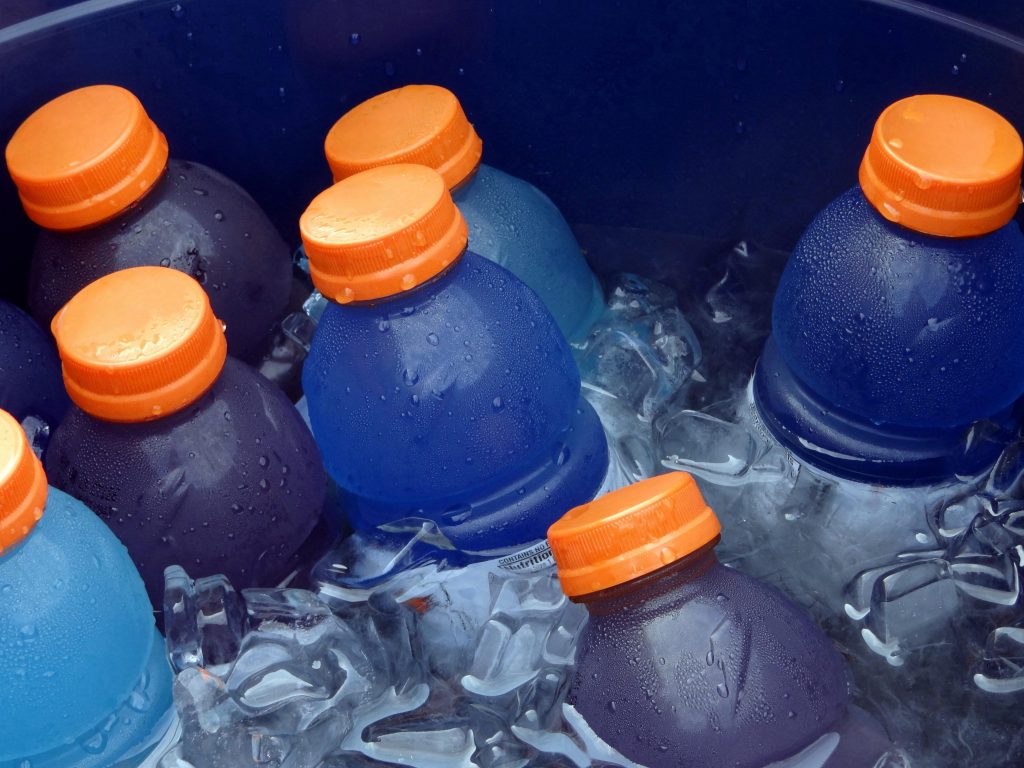
Electrolytes. You’ve all heard of them and probably know they have something to do with hydration. Sports drinks like Gatorade are often the first things to come to mind. But do you know what exactly electrolytes are and what they do for the body? Do they give you energy? Are sports drinks the best way to replenish them? How do you know when and if you need them? These are all questions that athletes, whether professional or recreational, need to know the answers to if they want to perform at their peak.
What are they? Electrolytes are minerals that carry an electric charge. They are essential to life and regulate our hydration, nerve and muscle function and blood pressure. Sodium, potassium, calcium, phosphorus and magnesium are all electrolytes.
When you sweat, you lose electrolytes. Low levels of electrolytes can cause muscle cramping or weakness, fatigue, loss of appetite, dizziness and confusion. Severe electrolyte deficiencies can cause seizure, paralysis and even death.
How do you know when and if you need to replenish electrolytes? If you take a quick jog around the block in 70 degree whether, you don’t need to worry about replenishing electrolytes. If you go to the gym and lift weights for 40 minutes, you’ll need protein for recovery but probably not electros. On the other hand, if you work outside in the garden for 5 hours in 85 degree weather, you do need to replenish and rehydrate. Unlike protein, needing electrolytes doesn’t depend on the level of difficulty of the activity; it depends on how much you sweat. Even a day at the beach lying in the sand can warrant the need for electrolyte replacement.
Whether you need factor electrolytes into your exercise recovery routine solely depends on your individual sweat rate. Do you have a salty puddle under your bike after a cycling class? Is there sweat dripping in a stream from the tip of your nose after a workout? Then you need electrolytes!
Sodium is the electrolyte that is lost the fastest when sweating, which is why your sweat tastes salty. However, most Americans get plenty of sodium and deficiencies are rare so don’t jump to start adding more salt to your diet. Take a quick look at your normal intake. Do you eat any foods that come in a package, drink sodas or energy drinks, or stock up on canned vegetables or soups? If you have to open it before you eat it, it probably has sodium in it. The daily recommended amount of sodium is 2300 milligrams a day or less for the general population.
You lose potassium, another important electrolyte, at a slower rate than sodium when sweating, but most of people aren’t even getting half of the 4700mg/day recommendation for potassium. All fruits and vegetables have potassium, but some of the potassium powerhouses include tomatoes, spinach and oranges.
Can I get electrolytes from food? Yes, absolutely. Any food that contains sodium, potassium, calcium, magnesium or phosphorus contains electrolytes. If you typically have a meal after exercise, you are probably getting plenty of electrolytes.
What about sports drinks? Gatorade, Powerade, Vitamin Water and the like are all high in sugar, calories and contain many dyes and artificial ingredients. For endurance athletes, those carbohydrates (from sugar) do serve a purpose. If your exercise lasts longer than 60 minutes, carbohydrate stores start to deplete. Sports drinks can help to replenish those stores, as well as restore electrolyte balance but that doesn’t mean you have to reach for Gatorade. There are other healthier, more natural alternatives:
Coconut water contains natural electrolytes like potassium and sodium that are lost during exercise. If you don’t need the extra carbs, make sure the coconut water you are consuming has no added sugars. Some coconut waters can have up to 20 grams of sugar in a serving — more than half a can of regular soda. Look for brands that contain 100% pure coconut water and nothing else, like 365 Everyday Value Coconut Water. One serving of coconut water (around 8oz) contains approximately 50 calories, 500 milligrams of potassium and 40 milligrams of sodium.
You can also make your own cheap and easy sports drink at home by squeezing any citrus fruit into a cup of water, adding honey or maple syrup to taste and 1/8 teaspoon of salt. Or, check out these dietitian’s recipes for homemade sports drinks:
Cucumber Lime Electrolyte Refresher by The Organic Dietitian
Natural Sports Drink by The Plant-Based Dietitian
Another alternative for electrolyte replacement is chocolate (cow’s or soy) milk. Chocolate milk is an optimal recovery drink for long, hard training sessions due to it’s natural combo of simple and complex carbs + protein. The simple carbs provide quick fuel replenishment while the protein — in the form of casein and whey — helps to build and repair muscle. Chocolate milk also provides the fluid needed for rehydration as well as sodium, potassium and magnesium.
Water alone does not contain electrolytes. If you are training for a specific endurance event, be sure to train with or trial the same sports drink that will be provided on race day.
Read more ore on electrolyte replacement from Nancy Clark, MS, RD, CSSD, respected sports nutritionist and author.
I was not paid for my opinions or for product. This link may contain one or more affiliate links.
